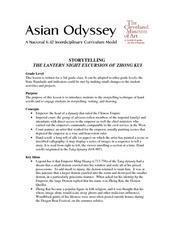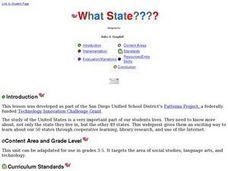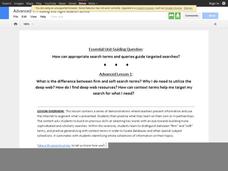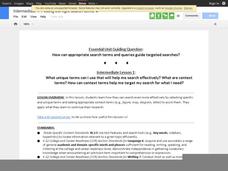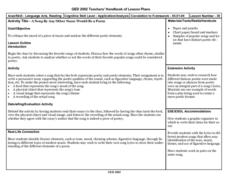Curated OER
What Interests You?
Fourth graders investigate math in the real world using internet search methods to locate career fields of interest. They select an occupation, and draft brief paragraphs that reflect insight as to why that occupation interests them.
Curated OER
Storytelling: The Lantern Night Excursion Of Zhong Kui
Third graders create Chinese hand scrolls to tell the story: The Lantern Night Excursion Of Zhong Kui in this cross-curricular lesson plan for the third grade. The lesson plan is adaptable to many different grade/ability levels.
Curated OER
Hip To Be Square
Students explore performing arts by reading a children's book in class. In this body movement lesson, students read the book Dance and create their own artistic impressions based on dancing images from the book. Students share their...
Curated OER
Building Buildings
Students work together with a partnet to design a building. Using materials, they create the inside and outside of the structure along with works of art. They present their creation to the class and receive constructive criticism in return.
Curated OER
What State????
Students study the United States. They research not only the state they live in, but the other 49 states. This webquest gives them an exciting way to study about our 50 states through cooperative learning, library research, and use of...
Curated OER
Reflections of Symmetry
Students use video and the Internet to identify examples of bilateral and radial symmetry in the world around them. They create symmetrical reflection designs using pattern blocks and paper.
Curated OER
Give Me the Money
Students view a money transaction on video and identify the steps involved in making a purchase and calculating change. They write out original money math problems and exchange them with classmates.
Curated OER
Flips, Sides and Turns: Exploring Transformations
Students use an online dictionaries to define key geometric terms. They explore several websites to help them differentiate the terms reflections, translations and rotations as they apply to geometry and then complete an assessment...
Curated OER
Shh! We're Writing the Constitution
Fifth graders research, examine and study about the three branches of the government and the contents of the Constitution including both the Articles and the Amendments. They create their own classroom constitution at the end of the unit.
Curated OER
NASA Plans Moon Base
Students react to statements about the moon, then read a news article about NASA's plans to build a permanent base on the moon. For this space science and current events lesson, the teacher introduces the article with a discussion and a...
Curated OER
Math for the Frontier
Make history come to life by using the Frontier House series to engage students in the past. Your class will "prepare" for a trip to 1833 Montana. They will learn about homesteading, frontier life, inflation, and cost of living. Using...
Curated OER
The Soundtrack of One's Life
Students research a historical person and the time in which he/she lived. They write a biography including images and at least four songs from the time period in which the person lived.
Mathematics Vision Project
Module 6: Trigonometric Functions
Create trigonometric functions from circles. The first lesson of the module begins by finding coordinates along a circular path created by a Ferris Wheel. As the lessons progress, pupils graph trigonometric functions and relate them to...
Curated OER
iPod Audio Tours
Students cooperate in small groups to create an audio tour of a zoo exhibit during a field trip. They record personal reactions, zoo sounds and information learned about the exhibit. They then edit the audio recording and add music to...
Utah Education Network (UEN)
7th Grade Poetry: Metaphor Poem
The second lesson in a five-part poetry unit asks seventh graders to construct a metaphor poem. First, pupils examine Emily Dickinson's "The Railway Train" and identify the metaphor. They then select an object and an animal and craft a...
Curated OER
Picturing Text
Students, through observation and discussion about the Coffin of Djed Mut, make connections between hieroglyphs and the English writing system. They create their own visual story using symbols that represent words.
Curated OER
What Shapes Can You See?
Students investigate shapes in art. In this visual arts lesson plan, students examine the ancient Panamanian "Plaque" and identify the geometric shapes in the art piece. Students combine basic shapes to make an artistic picture of their...
Google
Advanced 1: Picking the Right Search Terms
Many people, when searching online, will type in what they are looking for without much thought. But what's the next step, if they don't get the desired results? Careful selection of search terms. Your class can develop a sense for...
Google
Intermediate 1: Picking the Right Search Terms
A search can be strengthened by unique terms. With the activities and presentation included here, show your class how to target their searches with unique terms and context terms. They can then practice their search skills with...
Curated OER
San Diego Architecture
Eighth graders study the cultural and architectural history of San Diego. After study they create a design of a home based of features from historical and modern homes found in their research.
Curated OER
Shape Makes a Difference!
Learners learn the difference between perimeter and area by watching a video and a hands on activity.
Curated OER
Move To a Healthier Aquatic Balance
Fourth graders examine aquatic orgnaisms and how enviromental chages affect them. This factors include: temperature, Ph, oxygen, nutrients, and pollutants. They also explore habitat quality (erosion). Students compile data and create...
Curated OER
A Song By Any Other Name Would Be a Poem
Young scholars examine the poetic elements of a piece of music. They discuss favorite songs, select a song, and write a persuasive essay identifying the poetic qualities of the song lyrics.
Curated OER
Those Cells Look Good Enough to Eat
Students explore the parts of the cell. In this cell lesson, students use foods to create cell models that represent the nucleus, cytoplasm, cell membrane, mitochondria, ribosomes, vacuoles, endoplasmic reticulum, and Golgi bodies...



